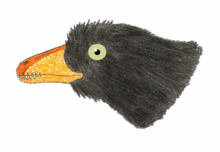Aorun
| Aorun | |
|---|---|

| |
| Scientific classification | |
| Domain: | Eukaryota |
| Kingdom: | Animalia |
| Phylum: | Chordata |
| Clade: | Dinosauria |
| Clade: | Saurischia |
| Clade: | Theropoda |
| Superfamily: | †Alvarezsauroidea (?) |
| Genus: | †Aorun Choiniere et al., 2013 |
| Type species | |
| †Aorun zhaoi Choiniere et al. 2013
| |
Aorun (
Discovery and naming
The
The
Description
The
It is estimated that the number of teeth in the
Size and ontogenetic stage
The specimen, as can be judged from the available
Diagnostic features
The describing authors established some diagnostic traits. In the depression for a skull opening, the
Aorun is different from other theropods discovered from the same region, such as
Phylogeny
The authors placed Aorun in a basal position in within Coelurosauria and a member of
Paleoecology
Provenance and occurrence
The remains of the type specimen of Aorun zhaoi IVPP V15709 was recovered in the
Fauna and habitat
The
References
- ^ S2CID 53538348. Archived from the original(PDF) on 11 January 2019.
- ^ a b Nosowitz D (3 May 2013). "New Dinosaur Species Found In China". POPSCI. Popular Science, A Bonnier Corporation Company. Retrieved 2013-05-04.
- ^ Gatin L (3 May 2013). "George Washington University Biologist Discovers New Dinosaur in China". Media Relations. George Washington University, Washington, D.C. Archived from the original on 2014-08-12. Retrieved 2013-05-04.
- ^ George Washington University (3 May 2013). "New dinosaur fossil discovered in China: Meat-eating dinosaur from late Jurassic period was less than a year old". ScienceDaily. ScienceDaily LLC. Retrieved 2013-05-04.
- ^ Gishlick, A. D. & Gauthier, J. A. 2007. On the manual morphology of Composognathus longipes and its bearing on the diagnosis of Compsognathidae. Zoological Journal of the Linnean Society, 149, 569–581.
- ^ Tykoski, R. S. 2005. Anatomy, ontogeny, and phylogeny of coelophysoid theropods. Unpublished PhD thesis, University of Texas at Austin, 552 pp.
- ^ Kammerer, C. F. 2010. Systematics of the Anteosauria (Therapsida: Dinocephalia). Journal of Systematic Palaeontology, 9, 261–304.
- ^ Tsuihiji, T., Watabe, M., Tsogtbaatar, K., Tsubamoto, T., Barsbold, R., Suzuki, S., Lee, A. H., Ridgely, R. C., Kawahara, Y. &Witmer, L. M. 2011. Cranial osteology of a juvenile specimen of Tarbosaurus bataar (Theropoda, Tyrannosauridae) from the Nemegt Formation (Upper Cretaceous) of Bugin Tsav,
- ^ ^ Xing Xu; Jonah Choiniere; Qingwei Tan; Roger B.J. Benson; James Clark; Corwin Sullivan; Qi Zhao; Fenglu Han; Qingyu Ma; Yiming He; Shuo Wang; Hai Xing; Lin Tan (2018). "Two Early Cretaceous fossils document transitional stages in alvarezsaurian dinosaur evolution". Current Biology. Online edition. doi:10.1016/j.cub.2018.07.057.
- ISSN 0891-2963.
- PMID 31409823.
- ^ Xu, X., Clark, J. M., Mo, J., Choiniere, J., Forster, C. A., Erickson, G. M., Hone, D. W. E., Sullivan, C., Eberth, D.A., Nesbitt, S., Zhao, Q., Hernandez, R., Jia, C.-K., Han, F.-l.&Guo, Y. 2009a. A Jurassic ceratosaur from China helps clarify avian digital homologies. Nature, 459, 940–944.
- ^ Choiniere, J. N., Clark, J. M., Forster, C. A. & Xing, X. 2010a. A basal coelurosaur (Dinosauria: Theropoda) from the Late Jurassic (Oxfordian) of the Shishugou Formation in Wucaiwan, People's Republic of China. Journal of Vertebrate Paleontology, 30, 1773–1796.
- ^ Xu, X., Clark, J. M., Forster, C. A., Norell, M. A., Erickson, G. M., Eberth, D.A., Jie, C.&Zhao, Q. 2006. Abasal tyrannosauroid dinosaur from the Late Jurassic of China. Nature, 439, 715–718.
- ^ Choiniere, J. N., Xu, X., Clark, J. M., Forster, C. A., Guo, Y. & Han, F. 2010b. A basal alvarezsauroid theropod from the early Late Jurassic ofXinjiang, China. Science, 327, 571–574.
